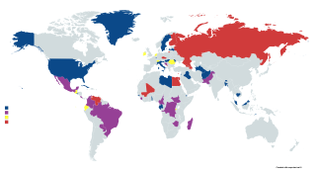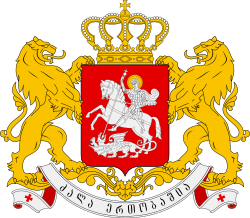
Fine Gael is a liberal-conservative political party in Ireland. Fine Gael is currently the governing and largest party in Ireland in terms of members of the Oireachtas and Irish members of European Parliament. The party has a membership of 35,000, and is the senior partner governing in a minority coalition with several independent politicians, with party leader Leo Varadkar serving as Taoiseach. Varadkar succeeded Enda Kenny as party leader on 2 June 2017 and as Taoiseach on 14 June; Kenny had been leader since 2002, and Taoiseach since 2011.
Switzerland is a semi-direct democratic federal republic. The federal legislative power is vested in the two chambers of the Federal Assembly, the National Council and the Council of States. The Federal Council holds the executive power and is composed of seven power-sharing Federal Councillors elected by the Federal Assembly. The judicial branch is headed by the Federal Supreme Court of Switzerland, whose judges are elected by the Federal Assembly.

The President of Georgia is the constitutional Head of State of Georgia as well as the Supreme Commander-in-Chief of the Defense Forces. They represent Georgia in foreign relations. The constitution defines the presidential office as "the guarantor of the country’s unity and national independence."
This is a list of past arrangements of Canada's electoral districts. Each district sends one member to the House of Commons of Canada. In 1999 and 2003, the Legislative Assembly of Ontario was elected using the same districts within that province. 96 of Ontario's 107 provincial electoral districts, roughly those outside Northern Ontario, remain coterminous with their federal counterparts.
Regular elections in Croatia are mandated by the Constitution and legislation enacted by Parliament. The presidency, Parliament, county prefects and assemblies, city and town mayors, and city and municipal councils are all elective offices. Since 1990, five presidential elections have been held. During the same period, nine parliamentary elections were also held. In addition, there were six nationwide local elections. Croatia has held two elections to elect 11 members of the European Parliament following its accession to the EU on 1 July 2013.
There are three types of elections in Denmark: elections to the national parliament, local elections and elections to the European Parliament. Referendums may also be called to consult the Danish citizenry directly on an issue of national concern.

Romania elects on a national level a head of state – the president – and a legislature. The president is elected for a five-year term by the people. The Romanian Parliament has two chambers. The Chamber of Deputies has currently 329 members, elected for a four-year term by party-list proportional representation on closed lists. The Senate (Senatul) has currently 136 members, elected for a four-year term by party-list proportional representation on closed lists.
Abkhazia elects on national level a head of state - the president - and a legislature. The president is elected for a five term by the people. The People's Assembly has 35 members, elected for a five-year term in single seat constituencies. Abkhazia is a one party dominant state. Opposition parties are allowed, but are widely considered to have no real chance of gaining power. The last elections seems to show a development towards a multi-party system.
The 1984 Australian Referendum was held on 1 December 1984. It contained two referendum questions, neither of which passed.
Estonia elects a legislature on the national level. The Riigikogu has 101 members, elected for a four-year term by proportional representation. A head of state - the president - is elected for a five-year term by parliament or an electoral college. Locally, Estonia elects local government councils, which vary in size. Election law states the minimum size of a council depending on the size of municipality. Local government councils are elected by proportional representation too.

Malta elects on a national level 6 MEPs representing Malta in the European Parliament, on a district level the legislature, On a local level the Local Councils and on a community level the Administrative Committees.

The Legislative Assembly of Queensland is the sole chamber of the unicameral Parliament of Queensland. Elections are held every four years. Voting is by the full-preferential voting form of the alternative vote system. The Assembly has 93 members, who have used the letters MP after their names since 2000.

The 99 MP Party was a small New Zealand political party that contested the 2005 General Election. It supported a reduction of the number of Members of Parliament from 120 to 99.
Voting in Switzerland is the process by which Swiss citizens make decisions about governance and elect officials. The polling stations are opened on Saturdays and Sunday mornings but most people vote by post in advance. At noon on Sunday, voting ends and the results are usually known during the afternoon.

Referendums are held only occasionally by the Government of New Zealand. Referendums may be government-initiated or held in accordance with the Electoral Act 1993 or the Citizens Initiated Referenda Act 1993. Ten referendums have been held so far. Seven were government-led, and three were indicative citizen initiatives.

The Moldovan referendum of 2010 was a nationwide referendum in Moldova held on 5 September on whether or not the country should amend the Constitution of Moldova to return to direct popular election of the president. Since 2001, the president had been indirectly elected by Parliament, with a supermajority of 61 seats required for election.. The voters are asked to answer the following question "Would you agree with the Constitutional amendment, which would allow the election of the President of the Republic of Moldova by the entire population?", voting for one of the proposed options: “Yes (for)” or “No (against)”. Of those who had cast their vote, 87.83% chose "Yes". However, the referendum did not pass because only 30.29% of voters turned out, short of the necessary 33% for the referendum to be considered valid.

This national electoral calendar for the year 2016 lists the national/federal direct elections held in 2016 in all sovereign states and their dependent territories. By-elections are excluded, though national referendums are included.

This national electoral calendar for the year 2018 lists the national/federal direct elections to be held in 2018 in all sovereign states and their dependent territories. By-elections are excluded, though national referendums are included. Specific dates are given where they have been known.













